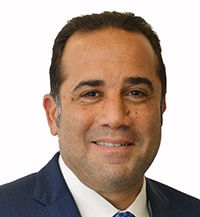Egypt is leading the region’s economic rebound, with special attention paid to nurturing the strong growth potential of smaller businesses.
Newly competitive Egypt is expected to be the fastest-growing economy in the Middle East in the next 12 months, as exports rise, more tourists visit the pyramids and a growing number of ships pass through the Suez Canal. With a population of more than 98 million, Egypt is reaping benefits from an ambitious program of reforms, including a 50% devaluation of the Egyptian pound in late 2016 and the introduction of a floating exchange rate and a value-added tax, as well as steep cuts in energy subsidies. Capital Economics forecasts real GDP growth of 5.3% this year and 5.5% in 2019.
“The government’s adoption of the current economic-reform program has put Egypt on track to be among the world’s most appealing emerging markets,” says Khaled El Salawy, CEO and managing director of ABK-Egypt, a subsidiary of Al Ahli Bank of Kuwait. Egypt’s competitiveness still has substantial room to grow, he says, and the government is updating legislation to enhance the investment climate and unleash the nation’s significant untapped potential.
“The Arab world’s most populous nation has begun to reap the benefits of this transformation, while making sure that the growth is more inclusive than in recent years,” El Salawy says. With the Egyptian currency closer to its equilibrium rate, resource allocation is becoming more efficient and exports are globally competitive, he says.

Foreign investment shows signs of picking up, as a result of the lower pound and government efforts to improve the business environment. The country’s foreign currency reserves rose to a record $42.5 billion in February. Egypt issued $4 billion of dollar-denominated international bonds on February 14, in a sale that attracted $12 billion in offers.
ABK-Egypt is not the only bank ready to support the recovery. “The banking sector in Egypt is in a relatively robust and resilient position,” says Hassan Abdalla, CEO of Arab African International Bank (AAIB). “The economy is now enjoying an unprecedented boom and overhaul across almost all sectors. Egypt is remarkable in spearheading growth in the region.”
As one of the leading syndication banks, AAIB has helped to channel foreign direct investment and portfolio investment flows to Egypt and the region. “Egypt has duly started structural reforms and taken serious steps to advance financial inclusion,” Abdalla says. “These measures are bold and impactful and are bound to trickle down to the large population. Naturally, it takes time.”
Expanding Opportunities
ABK-Egypt’s El Salawy highlights the room for growth in the country’s small and medium-size enterprises (SMEs) as a cornerstone of the government’s economic policies. The central bank has mandated that lending to SMEs constitute no less than 20% of a bank’s credit portfolio by the end of 2019. “The structural reforms underway are also making Egypt an increasingly attractive hub for manufacturers to set up shop and sell their products to the broader region,” he says.
Moody’s Investors Service estimates that Egyptian SMEs account for 80% of GDP and 75% of employment. “Despite the central bank’s initiative, loans to SMEs remain low at around 10% of total loans,” according to Moody’s.

“SMEs make a multidimensional contribution to the socioeconomic environment of a country,” Abdalla says. “They require minimal capital and are easy to start. They meet local demands and create employment opportunities.”
While AAIB plans to venture into the middle market to diversify its loan portfolio, Abdalla says microfinance is another crucial area. “Today there are seven million micro-SMEs in Egypt, with a credit gap of $10 billion,” he says. “Funding usually takes place through NGOs or corporates. That’s why AAIB has decided to serve the micro entrepreneurs through a dedicated subsidiary, Sandah, in partnership with [German development bank] KfW and the Sanad Fund for MSMEs.” Sandah will open in April 2018 to serve a diverse range of clients, Abdalla says.
Meanwhile, mobile-wallet technology is attracting unbanked customers and widening financial inclusion, El Salawy says. Customers can sign up for the service without opening a bank account. Since penetrating the Egyptian market less than three years ago, ABK-Egypt has expanded its footprint to cover the country with 39 branches. The bank’s earnings rose 206% in 2017 to $29 million, while deposits rose 43% and loans grew by 52%.
The unemployment rate—which reached an all-time high of 13.4% late in 2013—decreased to the lowest it has been since the Arab Spring: 11.3% at the end of 2017, from 11.9% in the third quarter of 2017. That’s still high enough to cause distress. “The government is investing in a social safety-net program that targets the poorest households and the most marginalized people in a bid to mitigate the pressures placed on this segment,” Abdalla says.

Natural Resources
Egypt’s economy could receive a further boost from rising natural gas production. President Abdel Fattah el-Sisi inaugurated the Zohr gas field at the end of January. Combined with the onset of production from a number of other fields, this will enable Egypt to be a net gas exporter this year for the first time since 2014, helping to overcome its current-account deficit.
“Rising natural gas production will boost Egypt’s GDP growth and incomes, while alleviating electricity blackouts. This will support activity in the manufacturing sector,” says Jason Tuvey, Middle East economist at Capital Economics. Egypt’s economy will accelerate as inflation falls back, interest rates are cut, and the pace of fiscal consolidation slows, Tuvey says. Inflation has fallen to 14.4% from a 30-year high of 33% in July 2017.
The Central Bank of Egypt’s easing cycle, which began on February 15 with a full-point cut in the overnight deposit rate to 17.75%, is likely to result in larger interest-rate reductions than most anticipate, Tuvey says. “We expect an additional 650 basis points of rate cuts by the end of 2019,” he says.
Economic growth in the wider Middle East and North Africa region slowed further last year, recording its weakest growth since 2009; but Tuvey believes a recovery is likely in 2018. In the Gulf, the drag from last year’s OPEC-agreed oil production cuts will fade, he says. Higher oil prices have prompted a shift toward slower austerity. Nonetheless, Capital Economics does not expect the regional recovery to gather pace in 2019, since it expects oil prices to fall back over the next two years.
MIDDLE EAST GDP GROWTH FORECASTS (PERCENT)
|
|
2018 |
2019 |
|
Saudi Arabia |
1.5 |
1.0 |
|
Egypt |
5.3 |
5.5 |
|
UAE |
2.8 |
2.5 |
|
Qatar |
2.0 |
2.5 |
|
Kuwait |
1.8 |
1.8 |
|
Oman |
1.0 |
1.0 |
|
Lebanon |
2.5 |
2.8 |
|
Jordan |
1.5 |
1.8 |
|
Bahrain |
2.5 |
2.5 |
Source: Capital Economics



